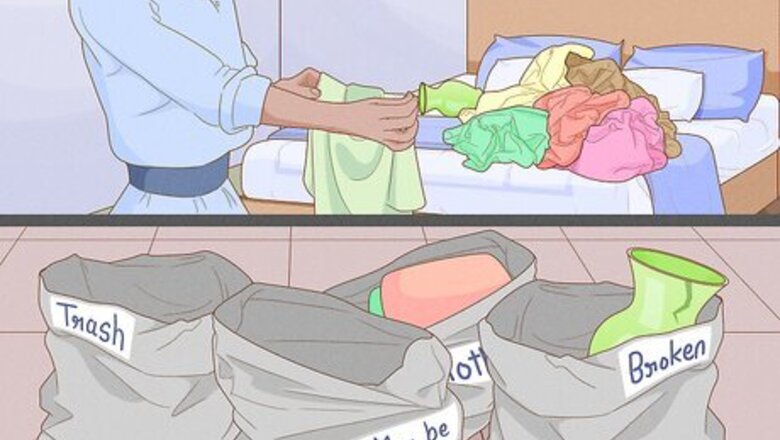
views
Getting Rid of Things from Your Room
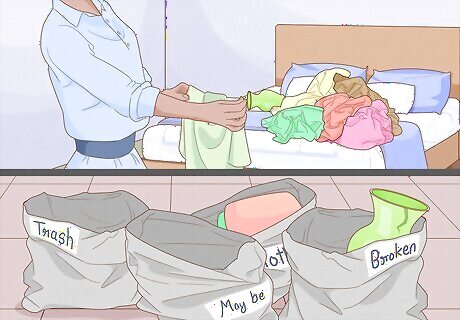
Go through your room with a trash bag. Get some trash bags (not just one) and empty all the garbage from your room. This could just be trash that's lying around, as well as ruined clothes or linens and broken items. If you’re not sure what can be thrown away, create a “maybe” pile or trash bag. You don’t have to throw anything away that you don’t want to. For your first sweep of the room, focus on getting the garbage out of your room.
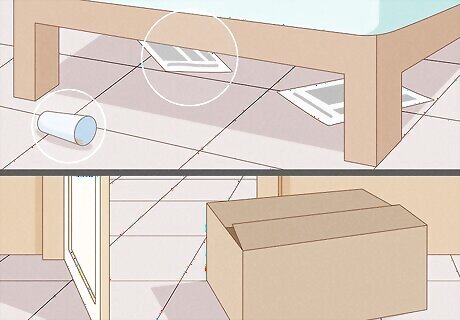
Remove anything that doesn’t belong. Spend about 10 minutes going through your bedroom to remove any belongings you have that do not belong in your room. Be on the lookout for dishes, paperwork, and loose change. Clear out the areas that are out of sight like under your bed and in-between furniture. It might help to completely remove these items from your bedroom. Set up a pile outside of your bedroom for miscellaneous belongings or trash. Then, take the time to put these items in their designated spots to avoid creating clutter in another room.
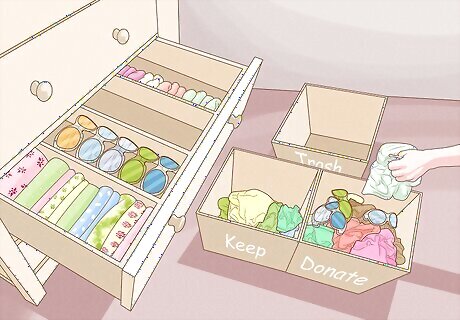
Go through your drawers. Take a drawer and remove all of its contents. Go through one drawer at a time. Make 3 piles: keep, donate, and garbage. Once you’re finished with one drawer, place all the “keep” items back into that drawer. Continue this process for each drawer. At the end of this process you can transfer the garbage items into the trash. Place the “donate” pile into a bag and set it aside for later. You can also offer items you are ready to get rid of to friends and family members. If in doubt, throw it out. It's okay to hold on to sentimental items that you aren't sure where to put. Set up a space or drawer for sentimental objects you feel inclined to keep. This includes things like letters, drawings, and ticket stubs.
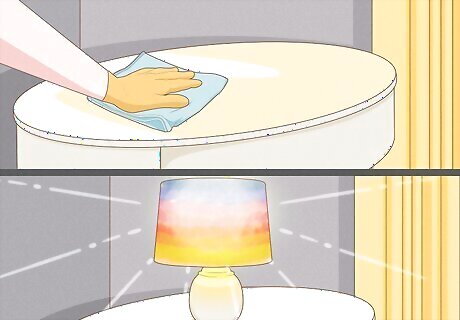
Clear all your surfaces. Go through all surfaces that have random belongings lying around. Put things away that are on desks, floors, tables, or nightstands. Be diligent while going through surfaces and attempt to truly clear everything. Don’t be afraid to get rid of items you don’t want or don’t use! If you plan to redecorate, it’s a good idea to purge as many things as you can. The only items that should be left around your room are things like a lamp, computer, or other items of decor. Once you’ve put everything back in its place, clean the surfaces. Take a moist rag to all countertops in your room.

Sort through your clothes. Now it is time to tackle your wardrobe. Start with a category of clothing like tops or pants. Keep all the clothes you frequently wear in their place unless there are clothes underneath them. This will take a while, but try on everything in your wardrobe. You might not have worn a pair of jeans for a while and find they no longer fit. For clothes you can make 2 piles: keep and donate. Many people enjoy or rely on used clothing. If you have a sentimental garment that doesn’t fit you, offer it to a friend or a younger sibling. At the end of the day, they’re just clothes and you can live without them.
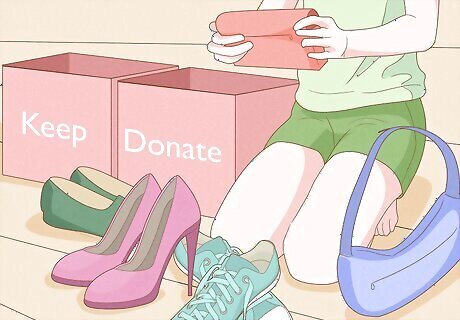
Go through clothing accessories. Look through your closet for shoes, bags, accessories, and coats. Do the same system you did with your clothes. Take time to truly consider if you need something or not. Hoarding belongings can affect the people around you and your quality of life. It’s better to get into the habit of recycling belongings as opposed to keeping all your old styles. If you have too many baseball caps, think about which caps you never wear. The caps you never wear are good items to be donated. Someone else will cherish the hat if you choose to donate it.
Cleaning and Organizing Your Room
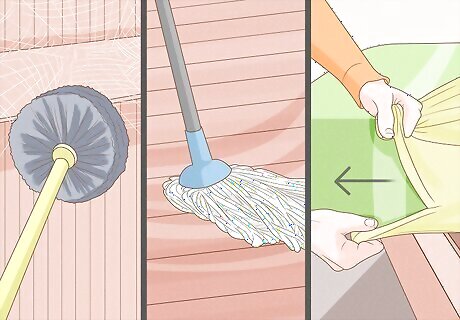
Clean your room. The best way to reset your room is with a clean room. Sweep and mop or vacuum the floors of your bedroom. Remove furniture to clean the entire floor. Wipe off all surfaces with disinfecting wipes. Spend time dusting the walls and corners of your room. Sweep or vacuum your closet. Use a cleaner to scrub the baseboards around your room. Change your bedding and wash your sheets and blankets.

Rearrange the furniture in your bedroom. It is healthy to rearrange your bedroom furniture now and again. Your bedroom becomes a new space that feels comforting and fresh. The first step is to find a new place for your bed. Consider your space and find a new place to put your bed. Then arrange the rest of your room around your bed. Try positioning your bed out of a corner and centered along a wall. As you rearrange your furniture, wipe off and clean areas of the furniture that were inaccessible before.
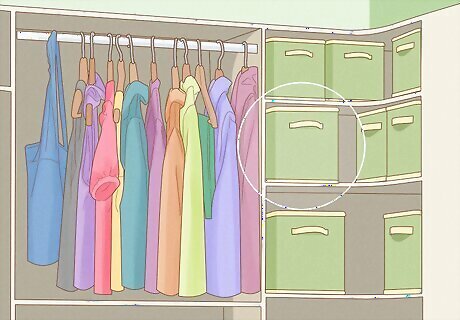
Organize your closet. Many clutter problems stem from not having enough space in a closet. If you only have a single bar and a shelf in your closet, consider giving it a makeover. Remove the single bar and invest in newer closet systems that can be found at furniture and home appliance stores. You can alternatively split your closet into 2 sections, such as a double bar hanger system on 1 side and a series of shelves on the other. This new type of system will remove more items from the floor and allow you to keep a more organized system in place. You can store excess and off-season items in storage organizers or even in another room to keep the closet from becoming cluttered.

Use drawer dividers. You can utilize your drawer space more by investing or creating dividers for your drawers. With drawer dividers you can keep several items that are vaguely related together in an organized way. For your everyday drawer, you can do the following: Keep your reading glasses in an individual section. Use one section for your cell phone. Keep your keys and wallet in a compartment. Have your loose hygiene products in a section. Place your book and notebook in another section. If you don't have drawers, get some bins or baskets to help with organizing your closet.
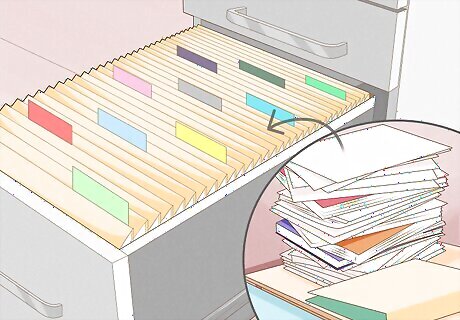
Set a place for paperwork. Paperwork is an easy to overlook obstacle that can clutter a space. Set up an area of your room, or outside of your room that will be the sole place for paperwork. Everyone has different needs and different amounts of belongings. Some will benefit from investing in a filing cabinet to keep all their filing needs in order. Others can get by with a binder or a series of folders in a drawer. Pick a system and enact that system as soon as you set it up. The best way to start using a new system is by implementing that system immediately. Another great option is to digitalize what's important and get rid of physical papers in your room.
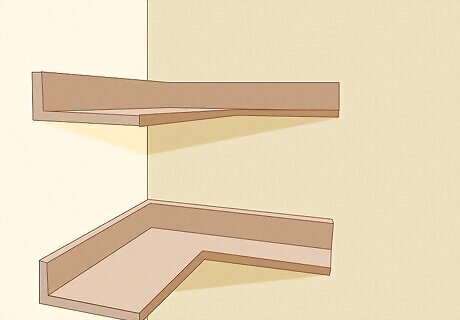
Install shelves. Shelves are an easy way to keep clutter off your floors. You can keep miscellaneous items or a collection of items together in an organized fashion with shelves. Go to a hardware store to purchase shelving holders and mount them onto your bedroom walls. Place the shelves high off the ground to avoid knocking into them. Decide what each shelf will be used for and avoid using them as a “catch all.” Make it a point to organize and dust them regularly.
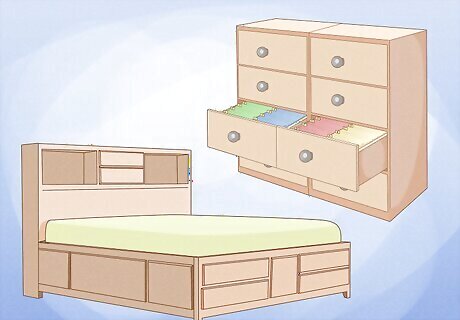
Use storage furniture. There are furniture options that can also act as a storage unit. These can be particularly helpful if you have limited closet space and need to fit linens and guest supplies through a season. You can find items like an upholstered storage bin from furniture stores. other types of furniture double as a storage space like a bed frame with drawers under the bed. You can replace your desk with several drawers for storing miscellaneous belongings. If you don’t have a dresser, consider getting one. You can even get a small dresser and store it in your closet. If necessary, get some clothing storage bags to slide under your bed.
Keeping Your Bedroom Free of Clutter

Put away your laundry after drying. A common way for clutter to start building up is after a load of laundry. Instead of shoving your cleaned laundry into your room, put it away immediately. When you fold your clothes fresh out of the wash, you decrease the chance of wrinkles. Fold, sort, and put away your clean clothes right after the wash. Avoid letting piles of clothing build up on the floor of your room. If you don't have enough room for your clothes, get rid of more clothes. If you need extra storage for your clothes, organize your clothes based on the season. Once it’s summer, store away all your coats and sweaters in a storage bin and place them in a community closet, garage, or attic.
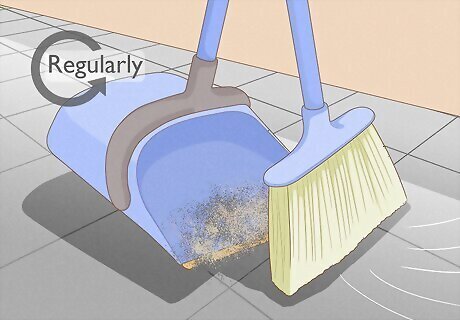
Clean your room regularly. Instead of waiting a couple of months to a year, do small bits of organizing and cleaning every day or week. If you have a small amount of clutter on your desk or in the corner of your room, go take care of it. Don’t let the mess build up. You can save yourself a hassle in the future by tackling bits of clutter as they form. You should plan to sweep/vacuum your room at least once a week. If you have a cat or dog, consider doing it more often.

Avoid over-buying. Many people have problems with hoarding materials or purchasing impulse buys. If you are one of these people, attempt to limit the number of belongings you purchase. One way to implement this is to consider where the belonging would fit into your room. Ask yourself: “Could this fit in my room practically?” and “Am I buying this for the right reasons?” If you are considering upgrading a belonging, decide if you’re willing to purge the original? It is okay to have decorations around your room, but too many can over clutter your walls and floor space.




















Comments
0 comment